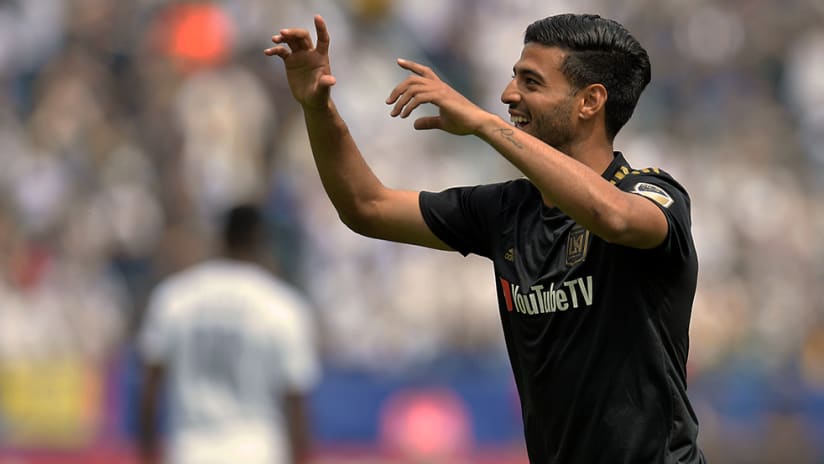It usually comes down to Carlos Vela, doesn’t it?
Move Vela 30 yards to the left, and you can turn a boring 0-0 into a thrilling 3-2.
On Sunday, when LAFC and the Portland Timbers played to a scoreless draw in the first of two matchups this week, Vela played as an inverted right winger. On Wednesday, in a U.S. Open Cup quarterfinal, Vela started in the center.
With the change came an LAFC win and, more importantly, the potential key to beating the hottest team in MLS.
LAFC and Portland have established themselves as two of the favorites in the Western Conference. They are second and third in the Western Conference on points per game.
But coming out of the MLS game on the weekend, Portland had the upper hand.
The Timbers traveled down to Los Angeles on Sunday and dictated the game. LAFC had more of the ball, but Portland controlled the rhythm and space. It’s a familiar song for Portland games this year. In fact, the Timbers have gotten the upper hand on pretty much everyone lately. They’ve now shut down NYCFC, Sporting KC, and Atlanta, three of the top five teams in MLS. The Timbers had made it clear to the league that they had Paper while others were only throwing Rock.
The impetus in Wednesday’s game then turned to LAFC. Could they find a way to break down Portland? It held repercussions not just for their future fortunes against a potential playoff opponent, but for all teams playing Portland moving forward. What’s the Scissors option?
LAFC might have found it.
In the first meeting, on Sunday, LAFC played Vela on the right with Lee Nguyen central. At the time, it seemed like a great decision to play Vela wide. Portland clogs the middle and makes it nearly impossible for central creators to find space. There is space, however, in the channels wide of the three central midfielders. Players generally have time from wider areas to pick up their head and find dangerous options -- connecting the pass into a clog area is another question, but presumably Vela would have the skill to cut perfect angles when given the time.

Vela was locked down by Portland on Sunday | USA Today Sports Images
It didn’t work out like that. Vela struggled to influence Sunday’s game.
On Wednesday, LAFC head coach Bob Bradley moved Vela back to the center. Vela caused problems for Portland all game. But not in the traditional No. 10 sense.
Generally when we think of the playmaker position, we think of the player taking up dangerous central positions around the opponent’s box. But Vela played a different role against Portland: The central spot put him in position to lead counters. A wide player generally has to track back to help protect the outside back, but the highest center midfielder (or withdrawn forward) doesn’t have as much defensive responsibility. As such, he’s primed to lead the counter.
And we’ve seen time and time again throughout Vela’s career -- particularly in his masterful performance against Germany in the World Cup -- how lethal he can be on the counter.
LAFC found in their two matches with Portland this year that they can’t pass through them -- LAFC held 59 percent and 56 percent possession in the first two meetings -- so they decided to hit Portland before they had to pass through them.
Maybe we have enough of a sample size to know that teams can’t break down Portland when they are back and set. Perhaps the only way to score against them is to transition their transitions.
Now, there’s more that factored into Wednesday’s game than just Vela’s positioning that we need to acknowledge. Two of LAFC’s goals came from set pieces, something they had clearly worked on prior to the game. Diego Valeri also didn’t play the first 80 minutes. The Timbers’ giveaways that led to Vela touches might not happen with Valeri on the field. But, overall, the game was much more open and LAFC looked much more dangerous than in the game over the weekend, and more dangerous than any team has been against Portland in a while.
It creates a potential blueprint for teams to consider when they play the Timbers:
- Play a transition-focused No. 10 (Vela rather than Nguyen; Jesus Medina rather than Maxi Moralez; Felipe Gutierrez rather than Yohan Croizet; Jefferson Savarino rather than Albert Rusnak).
- Give players, specifically that No. 10, the confidence to go for the transitions right away and take risks in transition. You can’t score once Portland get set, so don’t hesitate to go for it on a counter. Acknowledge that the low percentage transition attempt is better than any high percentage possession option.
And for LAFC, it’s a new club in their bag. We knew that LAFC could possess and play killer through balls to runners, but the idea of beating teams primarily on the counter is new. It’s not to say Vela should always play centrally; different opponents will demand different approaches. Nguyen or newcomer Andre Horta might be the right options on certain occasions. But Vela’s counterattacking speciality worked against the Timbers, and nothing else could make that claim in the last three months.
LAFC has multiple interesting questions moving forward: Who should start at striker, Adama Diomande or Marco Ureña? Does the midfield need more balance? How does Bradley find playing time for everyone? I hope to address them in future columns. But for now, it was a great adjustment from Bradley that will give LAFC confidence moving forward and other teams a potential blueprint to beat Portland.













